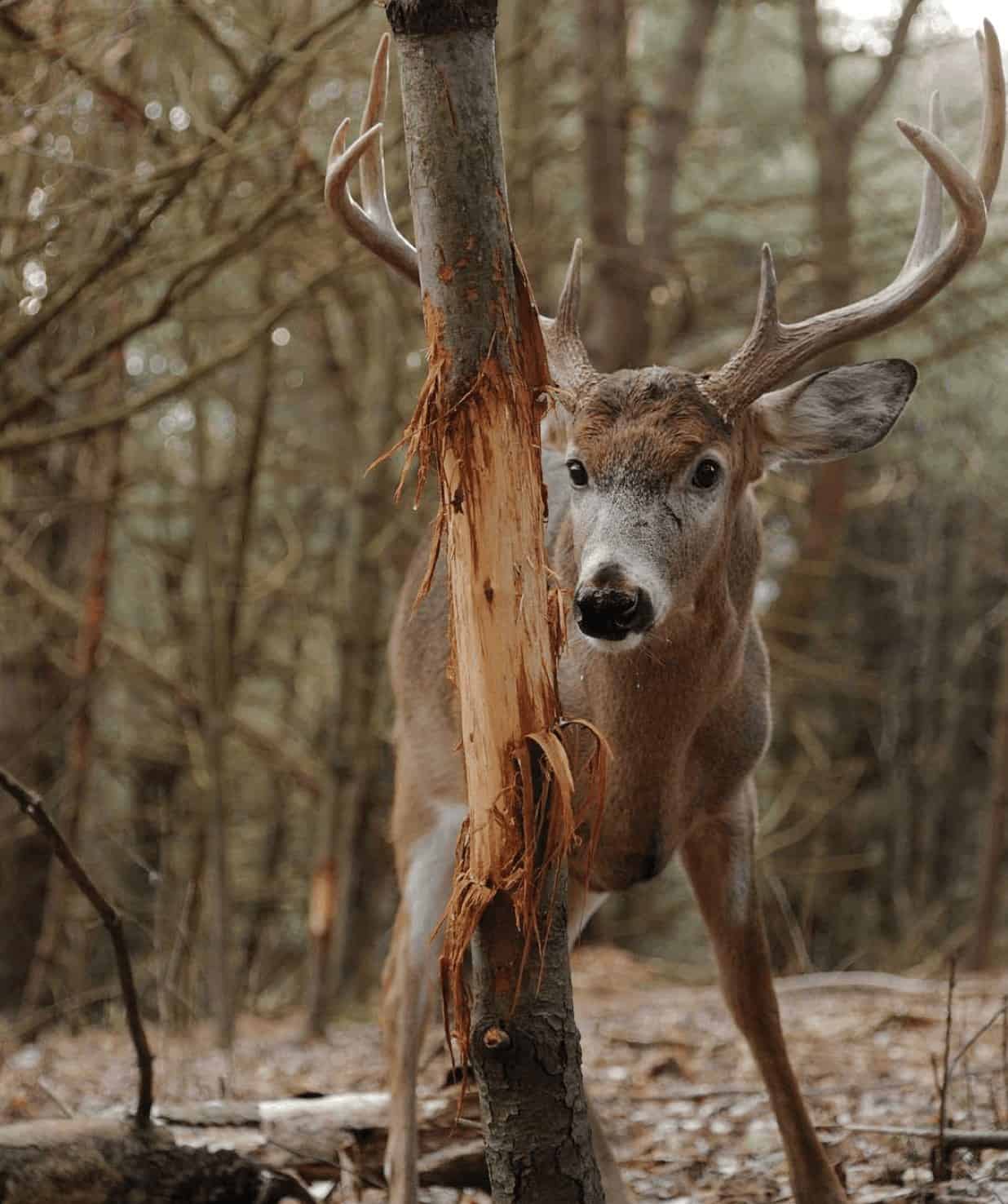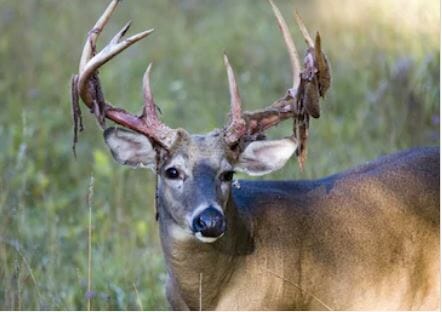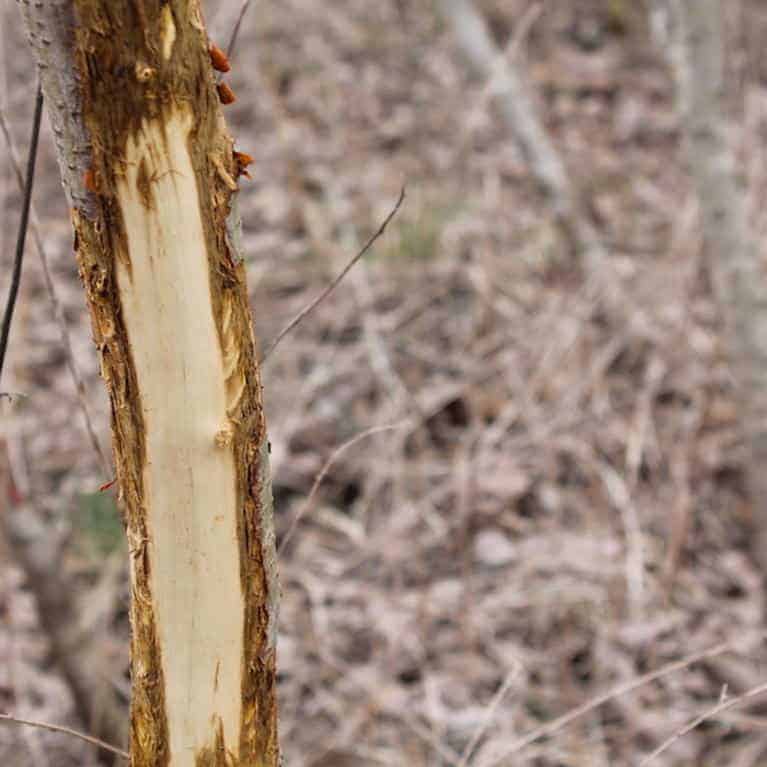When roaming through your neck of the woods, you have probably seen a tree with the bark rubbed off of one side. Depending on where you live, this is likely to be a type of deer. Have you ever stopped to think why bucks rub trees, or how you could use rubs to your advantage as a hunter? While this post will focus on whitetail deer, many members of the deer family Cervidae also make rubs in a similar fashion.
Why Would Deer Make Rubs?
Whitetails rub trees for two main reasons. After new antlers harden, bucks do this to remove the velvet from their antlers around early September. The second reason is to secret their scent in the area. This is an act of dominance showing other bucks what he is capable of. Because of this, the frequency of rubs sharply increases during the rut, and studies show that dominant bucks make three times more rubs than younger bucks.

What Is a “Rub”?
A rub is when a male whitetail uses his antlers to scratch the bark of a tree. This is an intentional act from the deer. They are very thorough and may scratch all the way around the tree or just one side. During September or pre-rut the purpose of this is to get the velvet off the deer’s antlers once they start to harden. During the Rut the purpose is to secret their scent on the tree and surrounding area, they are basically saying ” Hey ladies I am here!”. While simultaneously saying “Hey other bucks look how much I can tear this tree up, that could be you”.

When Do Bucks Make Rubs?
When deer antlers start to harden, it does not take very long for them to get rid of the velvet, maybe a few days at most. This process could start around late August and will probably be over for your local population by mid-September. So you will start seeing rubs around this time frame, with an increased frequency during the rut.
Which Deer Make Rubs?
While all bucks will rub to remove their velvet, during the rut, the majority of rubs will be made by more mature bucks rather than yearlings. In a population with a good amount of mature bucks, young bucks aging 1-2 may not get as many opportunities to mate and will likely get bullied around by older and bigger bucks. That being said, rubbing trees is an act of dominance around a certain area. So, it only makes sense that studies show mature (dominant) bucks are three times as likely to make rubs than younger bucks.
RELATED POST: HOW TO AGE WHITETAIL DEER
How to Tell the Difference Between New and Old Rubs?
A common mistake for novice hunters is to mistake a year old rub for a new one. While it could prove useful to see old rubs, we are generally interested in the recent ones that tell us where the deer are this year. Older rubs will be darker and greyed out while new rubs will be light brown or whitish with a bit of moisture to it.

What Makes a Good Rub?
As a general rule of thumb, the bigger the better. Smaller rubs can be on one side of the tree, but the holy grail of rubs is one that is rubbed all the way around, a rub like this says there is a buck coming back to this spot often. Some rubs can be on trees that are up to a foot around. Most of the rubs like this are communal. So this is a regularly visited rub by different bucks and could be a good place to do some extra scouting. Many times you will know a good rub when you see it just by sheer size, but another variable to think about is quantity. If there is an area around ten yards with multiple rubs, there is a good chance that is a high traffic area that you should definitely consider.
How Big Is a Deer From the Rub?
As we discussed, all bucks rub trees to remove velvet; however, most of them can tear up the middle of a tree and look like a giant buck to the untrained eye. The majority of the damage done is going to be from the two brow tines the buck has. These tines are the closest together and are around the same size as the tree that they would be rubbing. So just keep it in the back of your mind that a 2-1/2-year old deer can tear a tree apart as well as a bigger buck.
Do not give up, there is one difference between the two. While the middle is likely torn up in both cases, a mature deer rack has one advantage here that can help us differentiate between trophy and small racks. HEIGHT. Look at the very top of the rub, and the branches close to the ground. These can have small nicks or cuts, they will not be very large but only deer with taller racks can reach these spots, so the taller the nicks the taller (and bigger) the buck.
Around three feet is a normal height for a rub if you are using this method try to look around four or four and a half feet tall.
When Should You Hunt a Rub?
If you have identified a large rub and it is close to a few trails or a major trail, that is probably a good spot to hunt. Throw some corn out 10 yards away and see what happens (if your state allows it).
Better yet if you have found a cluster of rubs, close to a food source or major trail, I would mark that down as a stand location. Some hunters prefer to hunt in one spot for their entire season, but if you like to move around, Going from rub location to rub location can be a viable option for you.
What About the Tree?
There is no doubt that the tree gets the short end of the stick here. If it is only a small rub then the tree will likely recover but with a nasty scar and probably will lean to one side. If the rub is all the way around the tree has a really good chance of dying.
Thanks for reading my article about why whitetail bucks rub trees. I hope you enjoyed it and learned something you didn’t already know. If you like my content, subscribe to my weekly update. If you have any other questions about deer rubs or just want to connect, feel free to email me at Patrick.Long@omegaoutdoors.net.
